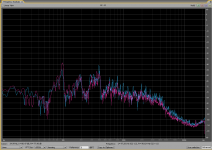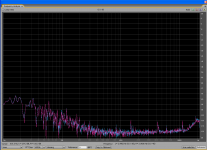Easy, just throw some random BS in a nice machined aluminium case and sell it for the price of a small car. 😀I will soon be able to design a 'high-end' preamp and impress journalists!!
Random noise is normally uncorrelated. How would it get correlated?Make sure the noise on the l&r channels is not correlated.
FWIW, re the earlier comments about "information": paradoxically, random noise contains more "information" than a sine wave. The sine wave is "deterministic", if you know its amplitude, frequency and phase now you can predict them at any point in the future, so it contains no information whatsoever.
The above discussion is a practical example of this: low-frequency noise carries information about the size of the acoustic space in which it exists.
Last edited:
By having a common source e.g. a common PSU. So 'high-end' preamps should have separate PSUs for each channel to help to de-correlate the noise. Separate mains supplies and quite different EMC characteristics would be even better. If one channel gets local AM interference and the other gets hash from Wi-Fi and mobile phones then this will be largely uncorrelated.scopeboy said:Random noise is normally uncorrelated. How would it get correlated?
Yes. I guess this falls into the category of 'not a lot of people know this'. Actually, it might be better to say that an information-rich channel sounds just like random noise.random noise contains more "information" than a sine wave
I don't know if it is, if you use a stereo device.Random noise is normally uncorrelated. How would it get correlated?
Simple test to check this is record the noise of a device, normalize and playback at normal levels. If it sounds like a point source its correlated, if you can't locate it its decorrelated.
Sound added.
To my knowledge:FWIW, re the earlier comments about "information": paradoxically, random noise contains more "information" than a sine wave. The sine wave is "deterministic", if you know its amplitude, frequency and phase now you can predict them at any point in the future, so it contains no information whatsoever.
The above discussion is a practical example of this: low-frequency noise carries information about the size of the acoustic space in which it exists.
A sine does have information: Amplitude, phase and frequency.
Noise has no information.
Or can we put information in the spectrum and amplitude of the noise?
Attachments
What kind of information is in there?Yes. I guess this falls into the category of 'not a lot of people know this'. Actually, it might be better to say that an information-rich channel sounds just like random noise.
An experiment anyone can try at home is to use FLAC to compress, say, 1 minute of white noise, and 1 minute of a 1kHz sine wave. Which gives the larger file? What is the implication in terms of information content?
White noise is the sum of all possible signals, the most information-rich signal possible in the bandwidth available. The only fundamental difference between signal and noise is that a "signal" somehow encodes a message of interest to humans. The more efficient the channel coding, the harder it is to tell the output from white noise unless you happen to know the key.
http://en.wikipedia.org/wiki/Kolmogorov_complexity
By a similar argument you can show that Skrillex is a higher form of music than Elgar. 😉
White noise is the sum of all possible signals, the most information-rich signal possible in the bandwidth available. The only fundamental difference between signal and noise is that a "signal" somehow encodes a message of interest to humans. The more efficient the channel coding, the harder it is to tell the output from white noise unless you happen to know the key.
http://en.wikipedia.org/wiki/Kolmogorov_complexity
By a similar argument you can show that Skrillex is a higher form of music than Elgar. 😉
Last edited:
You are of course right, but there is an 'information' and useful information. Noise may emphasize a sort of real information, but hides details that are buried more than some 20dB below noise level. In case of a cassette, there is definitely a loss of useful information (+ some new nonsense created)
Thanks, I think I get it.An experiment anyone can try at home is to use FLAC to compress, say, 1 minute of white noise, and 1 minute of a 1kHz sine wave. Which gives the larger file? What is the implication in terms of information content?
White noise is the sum of all possible signals, the most information-rich signal possible in the bandwidth available. The only fundamental difference between signal and noise is that a "signal" somehow encodes a message of interest to humans. The more efficient the channel coding, the harder it is to tell the output from white noise unless you happen to know the key.
Kolmogorov complexity - Wikipedia, the free encyclopedia
By a similar argument you can show that Skrillex is a higher form of music than Elgar. 😉
I have produced two files called Threshold 1 and Threshold 2
Threshold 1
Threshold 2
If anyone wishes to try these I would be interested to know what you hear.
Threshold 1
Threshold 2
If anyone wishes to try these I would be interested to know what you hear.
The "noise" in B, Y and Z tracks is not random.
By listening, I could only tell a difference in pitch between A and B; both sounded random. Y sounds random. Z sounds non random.
How can you tell B and Y are non random?
Question for all you digital gurus 🙂
Quick question while we have such a knowledgeable group of folk in this thread.
I have a Philips test CD containing 99 test tracks. The disc is playable on any standard player.
No PC I have tried it in will play it. Audacity will not import data from it. Why ?
Audacity gives a message saying the data has to be ripped to wav first. But I can't ! Media player says the tracks are "audio data only" and not playable. What is different about this test disc ? It is as "Red book standard" as its possible to get.
Quick question while we have such a knowledgeable group of folk in this thread.
I have a Philips test CD containing 99 test tracks. The disc is playable on any standard player.
No PC I have tried it in will play it. Audacity will not import data from it. Why ?
Audacity gives a message saying the data has to be ripped to wav first. But I can't ! Media player says the tracks are "audio data only" and not playable. What is different about this test disc ? It is as "Red book standard" as its possible to get.
.... and do not try WMP and similar stuff to rip the tracks. In case of low level signals like -80dB sine it will automatically increase the level.
To check low levels, try this
https://www.dropbox.com/s/fqkv5d85ifqxncb/sigtest80.wav
-80dBFS 24bit sine. It MUST sound very clean if you have a 24 bit card. In case it does not sound clean, something is going wrong. If you play it at 16 bits at full volume, it would not sound clean. I speak about analog volume, make no digital amplification.
https://www.dropbox.com/s/fqkv5d85ifqxncb/sigtest80.wav
-80dBFS 24bit sine. It MUST sound very clean if you have a 24 bit card. In case it does not sound clean, something is going wrong. If you play it at 16 bits at full volume, it would not sound clean. I speak about analog volume, make no digital amplification.
Mooly, the sigma-delta modulator you use is funny 😀. Is it DAC or software that makes all that noise shaping???
When you rip CDs with Windows Media Player, it may well be compressing the audio with WMA. 😱 Better to use Exact Audio Copy.
I think Mooly mentioned he used the line input on a Dell laptop. 😱😱😱
I think Mooly mentioned he used the line input on a Dell laptop. 😱😱😱
I have produced two files called Threshold 1 and Threshold 2
Threshold 1
Threshold 2
If anyone wishes to try these I would be interested to know what you hear.
Both complete silence.
Analogue gain to max, ears against speaker.
I only hear a tiny bit of noise, but it doesn't matter if a file is played or not. That is just the noise from my system.
- Status
- Not open for further replies.
- Home
- General Interest
- Everything Else
- Based on sonics... which do you prefer ?

